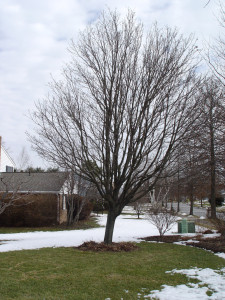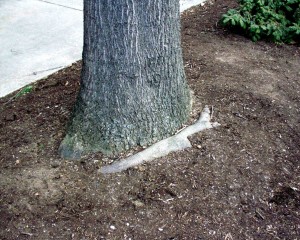Trees in Trouble?
January 27th, 2015
Winter is a good time to check your now-leafless trees to figure out if there’s anything you could – or should – be doing to head off brewing trouble.
Sometimes there’s not much you can do when a tree falls or cracks apart in a storm. A strong enough wind or nasty enough icing can cause even a completely healthy tree to fail.
But nature is less random than you might think. A combination of factors and weaknesses usually add up to put some trees more at risk of failing than others.
Winds, you might say, are merely the final blow.
These are some of the failure factors:
* Weak species. Some trees just have naturally weak branch or root systems.
‘Bradford’ and other flowering pears, willows, black locusts, tulip poplars, white pines and silver maples are among the “weaker-wooded” species. See a column I wrote on “Muscle Trees” for some of the strongest growers.
* Girdling roots. This is a problem in the making before you ever even buy the tree. Roots begin circling when they’re left in pots too long or when grown poorly in the field.
If these roots are not frayed out at planting, they may continue to circle and never reach out into the surrounding ground. That leads to poor support and possibly to roots that grow to strangle the base of the tree, leading to a snap-off in a wind storm.
* Bad place for a tree. Most trees don’t like low-lying spots, depressions and other spots where the soil is soggy. The roots rot, and the tree loses support.
A small island bed in the middle of an asphalt parking lot is not a good spot either. Nor is a skinny bed between a road and sidewalk.
Planting sun-loving species in the shade or shade-preferring species in full sun are also stresses that make trees more prone to bug and disease damage.
* Lousy soil. This is a biggie. Roots don’t penetrate clay very well, and they don’t grow deeply when 6 inches of topsoil is piled on top of compacted subsoil or solid rock (common practice in new development).
Limited roots can support a small tree, but the blow-over risk increases as the tree grows.
Just when the tree starts to reach a good size, it suddenly blows over.
* Too-deep planting. Also very common. Not only do people tend to plant trees too deeply (in part because they think that will give the tree BETTER support), but very often trees are already too deep in their pots. Or in field-grown plants, soil has been piled up against the trunk during cultivation.

No flare is visible at the base of this trunk, which means the flare is buried, and the tree is too deep in the ground and mulch.
Tree roots need oxygen, and they don’t get enough when they’re in the ground too deeply. Trees should be planted with the “root flare” clearly visible just above ground. The root flare is the point at the base of the tree where it starts to slightly widen as the trunk hands off to the root system.
Too-deep planting can kill some of the original root system, leading to the growth of shallower but weaker “adventitious” roots that can’t support a growing tree.
* Bad or no pruning. Done correctly, pruning is an aid to tree health, not punishment. Especially important is structural pruning while the tree is young.
Good pruning gets rid of rubbing branches, competing trunks and likely-to-split, sharply angled “V” crotches.
Unfortunately, many people don’t prune at all until the tree looks overgrown. Then they simply “top” it by shearing it like a bush. This only encourages a lot of dead stubs and new, weakly attached side shoots that are MORE likely to come off in a windstorm.

Pruning to think out excess growth can reduce “wind throw” and make a tree less likely to lose limbs in storms.
* Too-thick canopies. Most trees that are never pruned develop overly dense canopies that increase the wind’s force against the tree (known as “wind load” or “wind throw”).
If you thin excess branching, wind can blow through the tree instead of against it like a sail.
* Uncooperative weather. Both extended droughts and extended soggy periods can be bad news for a tree. Both can kill roots, which a tree needs both for support and growth.
Dry soil is more subtle and can be cumulative when hot, dry spells occur for several years in a row. You may not realize how many roots are dying until the tree suddenly dies.
Soggy soil tends to be a quicker killer as roots rot from lack of oxygen. Wet soil also is less stable than dry soil, so trees are at increased risk of blowing over when heavy winds follow a lot of rain.
This winter season, another curveball was a sudden fall cold snap that killed many tree and shrub leaves before they had a chance to turn color and finish their normal and gradual leaf drop. That’s led to brown leaves still hanging on many woody plants. I’m hoping that’s only a minor setback and not a sign that any plants suffered lasting injury from the quick cold shock.
* Poor tree health. Dead and dying branches are most likely to blow off first. Dead trees are coming down sooner or later. It’s nature’s way of cleaning the landscape.
That’s why it’s good to prune off dead wood as soon as you notice it – especially bigger branches that could fall on a car, person or roof.
Dead trees should be removed before they fall. They don’t always fall naturally in the direction where you’d like – or where you think, either. And a dead tree is not somehow going to come back to life miraculously.
Here are 10 steps you can take to help your trees:
1.) Thin out excess branches to allow wind to better blow through the canopy. You may need to hire a tree company to do this in bigger trees.

This is a tree with a double leader or “V-crotch” that’s likely to split apart like a turkey bone. One of the “V’s” should be removed when the tree is young.
2.) Prune correctly. Take off dead branches, eliminate a branch that’s rubbing against another, prune out the weaker of a “double leader” (two upright branches competing to be the main trunk) and prune out “V” crotches (branches growing more sharply vertical than horizontal). Don’t just randomly shear off branches.
Always cut back to a joint, leaving the little “branch collar” intact (the slightly raised, ringed area where two branches meet). Don’t leave stubs and don’t gouge into the trunk or remaining branch.
3.) Assess your trees’ health. Any cracked branches? Any wounds that are “bleeding” sap? Any fungal “mushroom” growth on the trunk or branches? Any dead stubs that have been infected? Pruning and/or carving out wounds may help solve smaller problems. Otherwise, the tree may have to come down.
4.) Is the tree leaning? This may be a sign of root loss or poor root growth. Younger trees sometimes can be straightened and restaked. Bigger, older ones are harder to correct and may pose a blow-over hazard.
5.) Distribute the weight. For trees that are growing with a bend or favor to one side, prune so that the center of gravity is as upright and evenly distributed as possible.
6.) Look at the tree’s base to see if it flares out before it goes into the ground. This root flare should not be buried. You may be able to pull back excess soil from a young tree. Some tree companies also have an air spade that uses high-pressure air to blow soil away from larger trees without damaging roots.
7.) Keep mulch several inches away from tree trunks and use no more than 3 or 4 inches of mulch. You don’t want to rot the trunk, and you don’t want to smother roots by burying them too deeply in mulch.
8.) Don’t operate heavy equipment anywhere near the canopy of the tree. That’s a good way to compact soil and injure roots.
9.) Never redirect drainage to an area where there’s a tree. Better yet, direct water away from trees if it threatens to pool and lead to soggy soil after rains.
10.) Never add more than 3 or 4 inches of soil later. This has the same effect as planting too deeply in the first place.










